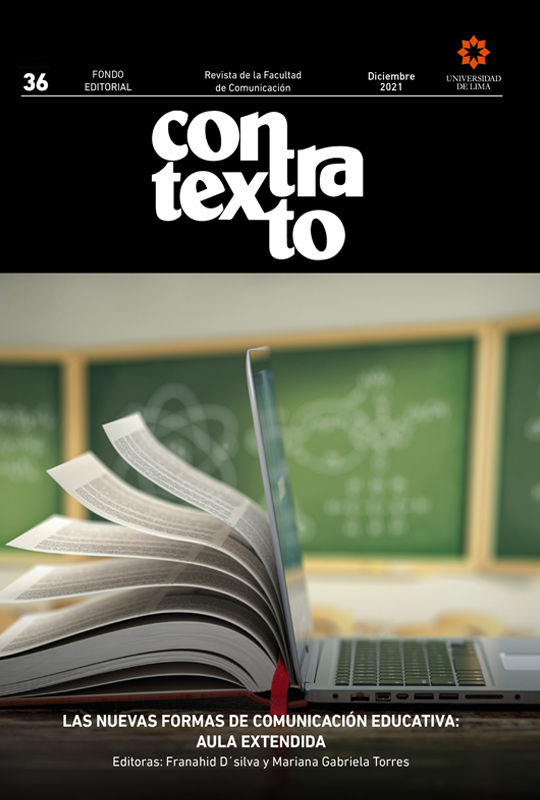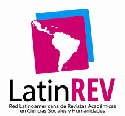Cuerpo y surrealismo: sobre el quiasmo en La tortuga ecuestre de César Moro y Un perro andaluz de Luis Buñuel
DOI:
https://doi.org/10.26439/contratexto2021.n036.5276Palabras clave:
surrealismo, César Moro, Luis Buñuel, cuerpo, Maurice Merleau-PontyResumen
Este ensayo tiene como objetivo explorar cómo el poemario La tortuga ecuestre de César Moro, escrito entre 1938 y 1939, y el cortometraje Un perro andaluz de Luis Buñuel, que vio la luz en el año 1929, dos obras emblemáticas de la vanguardia surrealista, abordaron la representación icónica del cuerpo. Este fenómeno es analizado, por un lado, desde la perspectiva del quiasmo hallada en la obra del filósofo Maurice Merleau-Ponty; y, por otro, desde las semióticas generativa (Algirdas Julien Greimas y Joseph Courtés) y tensiva (Jacques Fontanille y Claude Zilberberg). La conclusión a la que se llega es que dichas obras confirman que el discurso surrealista en la poesía y el cine toma a través de la iconicidad una conciencia del quiasmo al enfocar el cuerpo y el mundo como una sola entidad, de modo íntegro y unitario.
Descargas
Referencias
Alquié, F. (1974). Filosofía del surrealismo. Barral Editores.
Abbagnano, N. (2008). Diccionario de filosofía. Fondo de Cultura Económica.
Blanco, D. (2009). Vigencia de la semiótica y otros ensayos. Universidad de Lima, Fondo Editorial.
Breton, A. (1993). Poemas. Jaime Campodónico/Editor.
Courtés, J. (1997). Análisis semiótico del discurso. Gredos.
Coyné, A. (2015). Introducción de los coordinadores. En Moro, C., Obra poética completa (pp. XLVI-XLVIII). Alción Editora.
Dalí, S. (1936). Construcción blanda con judías hervidas (Premonición de la Guerra Civil) [Óleo sobre lienzo]. Philadelphia Museum of Art. https://philamuseum.org/collection/object/51315
Fernández Cozman, C. (2003). Las ínsulas extrañas de Emilio Adolfo Westphalen. Universidad Nacional Mayor de San Marcos, Fondo Editorial; Dedo Crítico.
Fernández Cozman, C. (2012). César Moro, ¿un antropófago de la cultura? Revuelta Editores.
Fontanille, J. (2008). Soma y sema. Figuras semióticas del cuerpo. Universidad de Lima, Fondo Editorial.
Garrido Gallardo, M. A. (2009). Fundamentos del lenguaje literario. En Garrido Gallardo, M. A. (Dir.), El lenguaje literario. Vocabulario crítico (pp. 9-236). Editorial Síntesis.
Greimas, A. J., y Courtés, J. (1990). Semiótica: diccionario razonado de la teoría del lenguaje. Gredos.
Lefort, D. (2015). Introducción de los coordinadores. En Moro, C., Obra poética completa (pp. XXIX-XLII). Alción Editora.
Magritte, R. (1964). Le fils de l’homme [Óleo sobre lienzo]. Wikipedia. https://en.wikipedia.org/wiki/File:Magritte_TheSonOfMan.jpg
Merleau-Ponty, M. (1993). Fenomenología de la percepción. Planeta-Agostini.
Merleau-Ponty, M. (2010). Lo visible y lo invisible. Ediciones Nueva Visión.
Moro, C. (2002). Prestigio del amor. Pontificia Universidad Católica del Perú.
Pellegrini, A. (2012). Antología de la poesía surrealista. Argonauta.
Quezada Macchiavello, Ó. (1992). Semiótica generativa. Bases teóricas. Universidad de Lima, Fondo Editorial.
Ramírez, M. T. (2013). La filosofía del quiasmo. Introducción al pensamiento de Maurice Merleau-Ponty. Fondo de Cultura Económica.
Richardson, M. (2006). Surrealism and Cinema. Berg.
Talens, J. (2010). El ojo tachado. Cátedra.
Vallejo, C. (2015). Obras. Colección integral. Amazon.com Services LLC.
Varela, B. (2016). Poesía reunida 1949-2000. Casa de Cuervos/Sur Librería Anticuaria.
Zilberberg, C. (2016). De las formas de vida a los valores. Universidad de Lima, Fondo Editorial
Descargas
Publicado
Número
Sección
Licencia
Todos los trabajos publicados están sujetos a una licencia CC BY 4.0 Creative Commons (actualizado el 1 de marzo de 2021).
El contenido de la revista se puede compartir en cualquier material o formato. Asimismo, se puede adaptar, contribuir y transformar. Ambas posibilidades sólo están permitidas en la medida en que cumplan las siguientes condiciones:
- Atribución: Se debe otorgar crédito donde sea debido, proporcionar un enlace a la licencia e indicar los cambios en caso se realice alguno. Esto debe hacerse de la manera que se considere apropiada, sin sugerir que el licenciante lo promueva a usted o su uso del material.
Derechos de propiedad
Los derechos patrimoniales de Contratexto se publican bajo una licencia Creative Commons BY 4.0, lo que permite a los autores mantener los derechos patrimoniales de su obra sin restricciones.
Si un trabajo publicado en Contratexto fuera copiado, distribuido, difundido o cualquier otra actividad contemplada en la licencia antes mencionada, se deberá mencionar de manera visible y expresa al autor o autores y a la revista.
Auto-archivo
Esta revista permite y anima a los autores/as a publicar artículos enviados a la revista en sus sitios web personales o en depósitos institucionales, tanto antes como después de su publicación en esta revista, siempre y cuando proporcionen información bibliográfica que acredite, si procede, su publicación en ella.


















